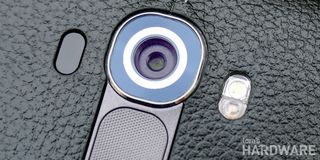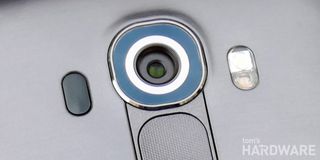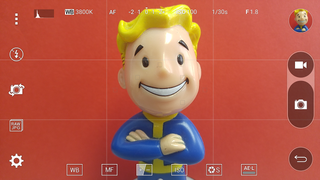LG G4 Review
The LG G4 retains a familiar look and still packs a removable battery and microSD slot, but it receives several internal upgrades, including a Snapdragon 808 SoC, an all-new camera, and a QHD IPS Quantum Display.
Why you can trust Tom's Hardware
Camera Features
The G3 introduced some unique smartphone camera innovations, including laser autofocus and 3-axis optical image stabilization (OIS). Despite these advances, the G3 was saddled with the same 13 MP Sony IMX135 image sensor as the previous year’s G2. In our review of the G3’s camera, we concluded that its innovations like OIS+ did partially compensate for it using an older sensor. However, it still lagged behind its competitors in a few areas such as capture time and low-light performance.

For the G4, LG seems to have taken much of the criticism leveled at the G3’s camera to heart, and this time around are using an up to date sensor, the new 16 MP Sony IMX234 Exmor RS. This new sensor is placed behind an f/1.8 aperture lens, which has the largest aperture of any phone. While the laser autofocus (AF) system has not changed, the OIS+ feature sees further improvement over the G3. The G4 also has a new Color Spectrum Sensor (CSS) that is supposed to improve white balance.
Note: For an explanation of camera hardware and terminology, please see our Camera Phone Technology 101 article.
Camera Sensor
Unlike some of Sony’s other recent smartphone camera sensors, the 16 MP IMX234 Exmor RS is a bit of a mystery, since we have not been able to find any documentation or spec sheets from Sony. Also, Sony’s naming conventions for its Exmor RS sensors are a bit confusing. The higher model number IMX240 used in the Galaxy Note 4, S6, and Note5 appeared before the IMX234, but the lower model number 21 MP IMX230 (used by the Moto X Play and Style) was released more recently. Because of this, we just cannot say which generation the IMX234 belongs to or what its exact feature set is.

We do know that this sensor is also used by the ZTE Nubia Z9, which has OIS but not phase detect autofocus (PDAF). Because the 16 MP IMX240, which is being used in a number of Samsung phones, uses PDAF, whereas the G4 uses Laser AF instead, perhaps the IMX234 is simply an IMX240 without PDAF support.
Based on LG’s spec sheet, the IMX234 is a 1/2.6" format sensor with a pixel size of 1.12μm, which is common for smartphone cameras. The native image capture aspect ratio is 16:9. If the G4’s sensor is indeed similar to the IMX240, then it should also support features like 1080p 60fps video and HDR video. However, these features are curiously unavailable in the G4’s video mode.
Optics and Features
When we reviewed the G3 last year, one of the weaknesses we identified was its f/2.4 aperture lens, which compromised the G3’s low-light performance relative to its peers, most of whom were using an f/2.2 lens and a few, like the Xperia Z3, using an f/2.0 lens.
To improve the G4’s low-light performance, LG pairs the new rear camera sensor with new optics. We’re currently witnessing a spec war when it comes to camera aperture. Earlier this year, Samsung released the Galaxy S6 with a fast f/1.9 lens, the largest aperture of any smartphone at the time. LG, of course, had to take things a step further by giving the G4 an even faster f/1.8 lens.
The new lens gives the G4 a 120% larger aperture area than the G3, which increases the amount of light hitting the G4’s camera sensor substantially. Compared to its competitors, the G4’s aperture area is 69% more than the iPhone 6 Plus’, 30% more than the HTC One M9’s, 27% more than the Galaxy Note 4’s, and 18% more than the Galaxy S6’s. On paper at least, the combination of a very bright lens, new sensor, and OIS should give the G4 excellent, if not the best, low-light camera performance.

One side effect of a larger aperture lens is a shallower depth-of-field (DOF). When taking close up pictures, the G4’s lens produces an attractive DSLR-like bokeh effect, even more than that of the Galaxy S6 which was already very good. The problem is that unlike a full-sized camera, where the aperture can be adjusted to control the DOF, the aperture is fixed on a smartphone. While the blurred background produced by the G4’s f/1.8 lens looks great most of the time, a shallow DOF is not desirable in every situation. The G4 pushes a fixed aperture lens about as far as it can go.
In addition to the new sensor and optics, LG also upgrades the G4’s three-axis OIS system to what it calls OIS 2.0. The new system improves motion compensation from 1° to 2°, which should help increase sharpness in still images and smoothness in video.
The G3’s laser autofocus system carries over to the G4. It uses an STMicroelectronics Time-of-Flight (ToF) VL6810 proximity sensor, which functions like an IR range finder. By measuring the time it takes IR laser pulses to travel to and from an object, the distance can be accurately and, more importantly, very quickly calculated, leading to very fast AF performance. While the G3 was notable for being the first phone with this AF system, the G4 now finds itself amongst a lot of company with laser AF too—notably the One Plus 2 and the new Nexus phones (5X and 6P).
A new addition to the G4’s impressive camera hardware suite is a Color Spectrum Sensor (CSS) that is supposed to improve auto white balance performance and produce more color accurate images. There is not much technical information available about this sensor, but from what we can tell it’s an RGBC (red/green/blue/clear) and IR sensor that can detect light sources and measure its color temperature. We’ll have to see in the camera comparison section if this sensor helps the G4 produce images with more accurate white balance.

The front-facing camera uses an 8 MP 1/4" Toshiba T4KA3 sensor that has a pixel size of 1.12μm and captures 16:9 images. This is combined with an f/2.0 lens that has a wider field of view than the G3’s front camera.
Camera Software
The other area that disappointed us on the G3 was the overly simplistic camera software. Clearly a response to the bloated, mode-filled camera UIs of Samsung’s 2013 phones like the Galaxy S4, LG perhaps went a little too far and made the G3’s camera UI too simple. Outside of an auto mode that produces decent images most of the time, the G3 lacks any kind of manual controls for even basic settings like ISO and white balance adjustments. So, to go along with the G4’s new camera hardware, LG retools its Camera app, taking advantage of the new camera API in Lollipop.

The stripped down “Simple” camera interface still exists on the G4 (shown above) as one of three different camera UIs. This basic interface allows you to capture an image by just tapping the screen, devoid of any other features or settings. While it’s not the G4’s only interface, it is an example of the simplification that LG has applied starting with the G3 to its camera UI.
Shown above is the second camera interface, “Auto”, along with all the camera modes available when using it. This UI has an actual shutter button (that can be held down to take bursts of images), a video record button, a flash toggle, and a button to switch between the front and rear cameras. Because the G4’s Auto HDR setting does not always activate HDR mode when necessary, we found ourselves turning it on manually quite frequently, which is why it’s unfortunate that the HDR toggle is tucked away in the settings menu instead of being easily accessible on the main screen.
In contrast to the plethora of modes that Samsung’s phones come with, the G4 only has three still camera modes: Auto, Panorama, and Dual. Both Auto and Panorama are self-explanatory, and Dual is a picture-in-picture mode that adds a windowed image from the front-facing camera. One G3 mode missing on the G4 is Magic focus, which blurred the background of close-up images as a post-processing effect. Since the G4’s f/1.8 lens produces this naturally, there is no need for it. The last mode shown is a shortcut to the video slow-motion mode.
There is one additional Auto mode that the user has no control over: Night mode, which is automatically turned on when shooting in very low light. When Night mode is active, the G4 applies heavy noise reduction in post-processing, causing a noticeable delay before you can take another shot.
The set of screenshots above show the options available in the settings menu. Below the aforementioned HDR toggle is the image aspect ratio control that sets the still image and video resolution. Unfortunately, the still image options only show the resulting aspect ratio and not the image resolution, which is a bit confusing. There’s also a toggle for the voice activated shutter, a button for the self-timer, and a toggle for guidelines. What you will not find in the G4’s Auto UI are any manual controls, not even exposure compensation. These are all reserved for the Manual UI.
There is one other feature we want to mention here and that’s the optional camera Quick-launch feature. By double-tapping the volume down button, it can open the Camera app or open the camera and automatically snap a picture. We rarely found that the latter option took any usable pictures, however. The camera (front or rear) that starts up when you use this feature is the sensor that was active during the previous camera session.
Manual Mode

Not since the Nokia Lumia 1020 have we seen a smartphone that offers the photographer the level of manual control that the LG G4 has (the Galaxy Note5 also has comparable manual mode now). In contrast to the simplification LG applies to the G4’s other camera UIs, its Manual interface lets you adjust almost every aspect of taking a picture. The G4 also captures RAW images that can be further edited with software like Adobe Lightroom for even more impressive results.
The Manual interface allows you to change the white balance, manually adjust focus, apply exposure compensation, change the ISO, and set the shutter speed. The only thing that cannot be adjusted is aperture, since that’s fixed attribute of the hardware. As seen in the screenshot above, the Manual UI is clearly laid out, with a small optional histogram in the top left, a row on top that shows you the current camera settings, and a row of buttons on the bottom to bring up the controls for each manual setting.
The animated set of screenshots above show how each setting is adjusted with an easy to use slider that appears to the left of the shutter button. Both white balance and focus can be left on auto, and shutter speed and ISO are automatically adjusted too unless you decide to make changes to them. Therefore, while it’s called Manual mode, it can still act as a more advanced auto mode. For example, you can adjust a picture’s exposure and just let the camera automatically adjust the other settings. The shutter speed can be set to a maximum of 30 seconds, useful for creative long-exposure shots, and goes as fast as 1/6000 second. Manual ISO ranges from 50 to 2700, an impressive range for a smartphone.
One notable and important difference between the G4’s Auto and Manual interfaces is that in the latter there is no post-processing applied to the pictures. Therefore, you can expect to see more noise grain in images taken while using the Manual interface, especially at higher ISOs, because the G4’s noise reduction algorithm is not used. Depending on your intent, this noise can be aesthetically pleasing, giving images a grainy, shot on film look, or distracting. Of course, you can also take the RAW copy of the image into your favorite image editing software and use its noise reduction processing, which may be better than what the G4 does anyway.
Replacing the Mode button on the left of the screen is a toggle to turn RAW capture on or off. The settings menu offers the same image aspect ratio options (still does not show resolution) and toggles for the voice-activated shutter and self-timer as seen in the Auto UI. You can also choose between guidelines or an overlay that shows if the phone is being held level. The histogram can also be turned off, although with it taking up so little space, we do not see the point.
Although the G4’s Manual mode is feature packed and surpasses what’s available on almost every other smartphone, it’s still missing a few features that we’d like to see implemented in future updates. One glaring issue is that there is no shutter priority option. As soon as you starting adjusting ISO or shutter speed the exposure is locked, and you have to manually adjust both settings to produce a correctly exposed image. While there are times that you want to have this level of control, there are other times when you just want to force a fast or slow shutter and have the camera automatically set the correct ISO for a properly exposed shot. Another problem is that when using manual focus there is no focus peaking or a zoomed-in area that allows you to easily and accurately see if your subject is in focus. Also, there’s no way to adjust the camera exposure mode from center-weighted to matrix or spot metering. All these missing features are ones a ‘real’ camera would have and show that despite how good the G4’s manual mode is, it’s still a smartphone, not a camera.
It’s also worth mentioning that the manual controls are not available when shooting video. It seems this is reserved for LG’s video-centric V10 phone.
Front-Facing Camera

The front-facing camera can use the minimal Simple or Auto UIs. There is no manual mode for the front camera. In Auto, there’s a Dual mode that overlays an image from the rear camera in a positional window, and a beauty slider that softens skin tones and hides blemishes. Like the beauty mode of every phone we’ve tested, it looks horribly fake when turned up more than about a quarter of the way. This feature can be turned off if you’re already beautiful enough.
The G4 includes LG’s Gesture view, a feature that lets you review a selfie by quickly bringing the phone closer to you after you’ve taken a picture, and Gesture Shutter, which activates the shutter when you open and close your hand. There’s also a toggle to mirror the captured image, which fixes reversed text, a toggle for a self-timer, a toggle for the voice-activated shutter, and the ability to adjust the image aspect ratio. The front-facing camera also includes an option for automatic HDR.
Another neat feature is the G4’s Selfie Light that reduces the viewfinder image size so the borders of the screen can be white. This provides a soft light to brighten up selfies shot in lower light in lieu of a proper flash.
Video
The Snapdragon 808 in the G4 is capable of encoding and decoding up to 4K UHD H.264 video in hardware, which brings better performance and lower power consumption. While it can also decode 4K UHD H.265 video in hardware, encoding must still be done in software. It makes sense then that the G4 sticks to H.264 for all video encoding.
Rear Camera Video Modes
| Video Mode | Resolution | Frame Rate (fps) | Video Bit Rate (Mb/s) | Video Codec | Profile | Audio Codec | Audio Bit Rate (kb/s) |
|---|---|---|---|---|---|---|---|
| UHD4K | 3840x2160 | 30 | 30 | H.264 | High | AAC (48kHz) | 156 |
| FHD1080p | 1920x1080 | 30 | 17 | H.264 | High | AAC (48kHz) | 156 |
| HD720p | 1280x720 | 30 | 12 | H.264 | Baseline | AAC (48kHz) | 156 |
| Slo-mo | 1280x720 | 120 | 24 | H.264 | Baseline | AAC (48kHz) | 156 |
Front Camera Video Modes
| Video Mode | Resolution | Frame Rate (fps) | Video Bit Rate (Mb/s) | Video Codec | Profile | Audio Codec | Audio Bit Rate (kb/s) |
|---|---|---|---|---|---|---|---|
| FHD1080p | 1920x1080 | 30 | 17 | H.264 | High | AAC (48kHz) | 156 |
| HD720p | 1280x720 | 30 | 12 | H.264 | Baseline | AAC (48kHz) | 156 |
Despite the faster processor and upgraded camera sensors, nothing much changes when it comes to shooting video with the G4. There’s still no 1080p@60fps option, for example, and the bit rate for 4K video remains unchanged at a relatively low 30 Mb/s compared to the 48 Mb/s used by Samsung’s latest Galaxy devices or the 42 Mb/s used by the Nexus 6. Speaking of bit rates, the G4’s 1080p video drops to 17 Mb/s, the same as the current Galaxy devices, but lower than the 20 Mb/s rate used by the G3. The G4’s audio bit rate is fairly conservative too, considering the Galaxy S6 uses 256 kb/s AAC encoding for all of its video modes. There's still a five-minute recording limit for 4K video and the ability to capture still images while recording 4K video is disabled.
The lack of HDR when shooting video is another disappointing holdover from the G3. This definitely degrades video quality and is a curious omission considering that the G4’s hardware supports it, as do competing phones such as the iPhone 6s Plus, Galaxy S6 edge+, and Moto X Pure Edition. The G4 does use optical image stabilization in all rear camera video modes, but unlike the Galaxy phones, it does not have an option for digital image stabilization. Like we saw on the Galaxy S6, using the G4’s OIS in video mode adds a weird, wobbly effect whenever the camera changes direction, which digital image stabilization helps to remove.
The G4’s video quality is mixed and similar to its still photo performance. In bright light, 4K video looks good with lots of detail and minimal noise. In lower-light conditions and indoors, the G4’s noise reduction works well, producing video with far less noise grain than the Galaxy S6. The downside to this post-processing, however, is that the G4’s video is less sharp than the S6’s and some of the finer surface textures are lost. The tradeoff between noise and sharpness comes down to personal preference, but when it comes to white balance, the S6 is the clear winner. In many situations, the G4 sets the white balance pretty close to ideal, but there are times when things go awry. For example, shooting video in a room lit by a fluorescent lamp will result in cooler colors when the camera is facing the lamp, but as the camera pans away, the video suddenly takes on a very noticeable yellow tint, an issue that neither the iPhone 6 nor Galaxy S6 exhibit. When situations like this occur, there’s really nothing you can do since there are no manual controls available when shooting video.
The G4 does use continuous autofocus when shooting video, which helps keep your subject looking sharp as it moves towards or away from the camera. However, it’s nowhere near as fast and reliable as either the S6’s or iPhone 6’s autofocus. In many situations, the laser does not work and the G4 falls back to the slower contrast detect autofocus method. There are also far too many times where autofocus fails completely, requiring you to tap an object on the screen to bring the video back into focus.
In most regards, the video experience on the G4 is the same as the G3. The lack of HDR and digital image stabilization hurt video quality, as do the relatively low bit rates used for video encoding. The inconsistency in white balance and autofocus performance do not help either, and there’s still no 60fps video option for creating smooth action videos. While the video experience with the G4 is not bad, it’s clearly not on par with some other flagship phones.
Current page: Camera Features
Prev Page Display And Audio Next Page Camera Performance And Photo QualityStay On the Cutting Edge: Get the Tom's Hardware Newsletter
Join the experts who read Tom's Hardware for the inside track on enthusiast PC tech news — and have for over 25 years. We'll send breaking news and in-depth reviews of CPUs, GPUs, AI, maker hardware and more straight to your inbox.
-
cknobman Wife absolutely loves this phone and glad she picked this over the Samsung S6.Reply
While it does not have quite the specs the Galaxy S6 does the microSD slot and the removable battery make it the easy choice.
LG gave her a free premium leather cover and a extra battery with charging cradle.
Sealed batteries are terrible because when they go bad you either ditch the phone or pay big money to have it replaced.
I learned the hard way with my last phone that had a sealed battery, it will never happen again. -
geosol62 DONT YOU THINK THIS REVIEW IS A DAY LATE???? WTF!!!Reply
GET WITH THE Z170 ROUND UP ALREADY! -
jimmysmitty Reply16981641 said:Wife absolutely loves this phone and glad she picked this over the Samsung S6.
While it does not have quite the specs the Galaxy S6 does the microSD slot and the removable battery make it the easy choice.
LG gave her a free premium leather cover and a extra battery with charging cradle.
Sealed batteries are terrible because when they go bad you either ditch the phone or pay big money to have it replaced.
I learned the hard way with my last phone that had a sealed battery, it will never happen again.
I agree that a SD card slot would be nice but the battery is something I am not as convinced because most people move on from a smart phone in two years (now sooner with the new way they do their plans) and I have had a lot of phones and never had a battery die in that two year period. Only one of them started having issues with longevity of use and that was the Droid Bionic I had that was known for having horrible battery life.
The microSD is very nice though for music and pictures, especially if you use FLAC quality audio or take a ton of pictures.
I hops Samsung at least puts that back into the S7 but then again the Lumia 950XL looks very tempting especially with the USB Type-C and docking station. -
Rob_9_ The G5 could well be launched in 7-8 weeks. Tom must've been writing this this review for a good while ;-) I have a G4 - it's fast, reliable, skinny, has a beautiful display and you can swap the battery out when it gets low.Reply
LG work closely with Google and Quallcomm to get fast(ish) updates and searing performance.
The headphone jack is on the bottom so it doesn't dangle weirdly and obtrusively from the top of your device like most other handsets. Plus, you can edit the nav keys any way you want which is a welcome relief from the awkward placement of the stock buttons.
I've owned loads of phones. Ignore these benchmark and gamut 'ratings'. This phone really is awesome. And it's now very cheap. -
cknobman ReplyI hops Samsung at least puts that back into the S7 but then again the Lumia 950XL looks very tempting especially with the USB Type-C and docking station.
I have a Lumia 950xl on pre-order, ships Nov 25th.
Looking forward to it. -
SamSerious Apart from this review being more than late, i stopped reading after the first ten sentences. It is nonsense that early LG phones lacked quality and were copies of what Samsung offered at the same time. The firmware often spoiled the otherwise good phone, ok, but e.g. the build quality was always very high, these things were built like bricks. Even my Optimus P880 ist way more solid than any Samsung Andorid phone i know.Reply -
innocent bystander Got a G3 and nothing I see here makes me want to upgrade.Reply
Then again, I'm the type of smartphone user for whom a full charge will last 3 days... -
ptrick2000 It was impossible for me to delve into the review itself after reading the first paragraph. The Monkees later output produced generally great records? This analogy is an insult to LG.Reply -
SirGCal The V10 is out for everyone accept Sprint and the G4 Pro (GIMME GIMME GIMME) is rumored to be right around the corner. So this does seem a bit late.Reply
